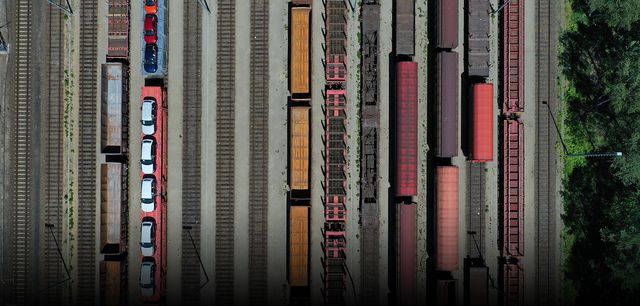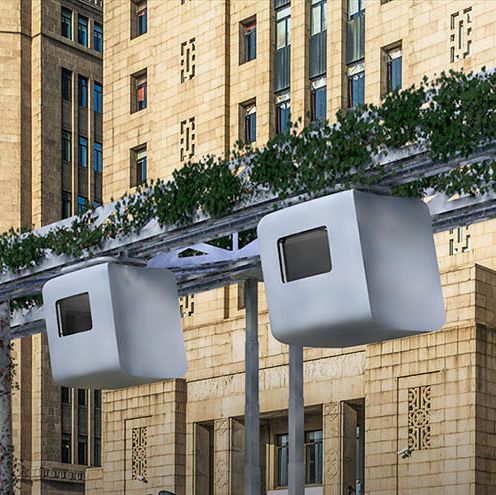18. March 2021
Aside from the bicycle, no other means of transport moves people and goods around in a more environmentally friendly way than the railways. There is of course still much room for improvement, and that is not limited to more efficient trains and greener electricity from the overhead power line. Deutsche Bahn vehicles consume some 250 million litres of diesel a year – and this is supposed to go down to zero by 2050. To get this plan on track, the company is testing more environmentally friendly drives and fuels. Regional train operators are also planning alternatives to diesel.
From the outside, only the grey stripe distinguishes the advanced TrainLab from a normal InterCity express train. Instead of passengers, however, the train’s principle cargo is the various pieces of equipment DB is using to test technical innovations, such as the synthetic diesel that this mobile laboratory is powered by. The organic diesel is mainly produced from organic waste materials such as used fats and cooking oils. This saves on carbon dioxide in the production of the fuel because the residues do not have to be produced separately.
The bottom line is that this biodiesel should reduce CO2 emissions by up to 90 percent compared to mineral oil and that it can easily be used in today’s engines: according to DB, the test train’s diesel engines run smoothly without any need for technical conversion. The Sylt Shuttle, which runs between Westerland and Niebüll on the North Sea island of Sylt, has also been trialling this more climate-friendly fuel since October 2020. Further tests in regular railway operations are planned.
However, the ultimate answer to the diesel problem is not organic fuel. It is significantly more expensive than conventional diesel, and used fats and other residual materials are not available in unlimited quantities. Its use on the railways could in future also compete with air transport, where no serious alternative to liquid fuels has yet emerged for long-haul flights. For this reason, Deutsche Bahn sees biodiesel as the choice of last resort for applications where a switch to battery, hydrogen or hybrid locomotives would not be economically viable.
“Dual-fuel locomotives” and hybrid trains
In the future, Deutsche Bahn’s freight railway subsidiary DB Cargo intends to focus more on dual-fuel locomotives. Depending on the route, such trains can run on either electricity or diesel. This is an environmentally friendly compromise for what has always been a dilemma: diesel locomotives are still used today to take individual freight wagons to the private rail connections of the customers for whom they are intended. Even if the main line is electrified, there is usually no overhead line on these final sections of track. Dual-fuel locomotives solve this problem by running mainly on electricity and using diesel only when no overhead cable is available. DB Cargo has already ordered 100 dual-fuel locomotives from Siemens, and this number could eventually be bumped up to 400 in total – an acquisition that would cost the DB subsidiary more than one billion euros. The first dual-fuel locomotives are scheduled to take to the tracks in 2023.
DB Cargo also plans to use hybrid locomotives to handle shunting operations with a reduced use of diesel. Their electric drive will only be supplemented by a diesel engine when particularly large amounts of power are required. According to DB, 50 to 75 percent of the operating time can be managed by the battery-powered electric drive. Fuel consumption should in this way be reduced by 50 percent and pollutant emissions by up to 70 percent. DB Cargo has ordered 50 hybrid locomotives from Toshiba for shunting operations, and a further 50 rail vehicles have been ordered by logistics partner Railpool.
© SiemensHybrid locomotives like these from Siemens could make the "last mile" in freight transport more environmentally friendly.
Alternatives for the secondary lines
Diesel is still particularly prevalent on low-traffic secondary routes. Where 98 percent of long-distance trains use electricity, the total decreases to a mere 63 percent in local transport. The electrification of secondary lines is progressing very slowly and is generally very time-consuming – nor is it always regarded as the ideal choice from an economic point of view. This is because, where a train only runs once an hour, new overhead lines often do not pay off. Regional transport operators are therefore increasingly turning to hydrogen.
“Technically speaking, hydrogen trains can compete with today's diesel railcars in many areas of application.”
Two fuel cell trains from French manufacturer Alstom have been transporting passengers from Buxtehude to Bremervörde since September 2018. By 2022, the fleet is expected to grow to 14 hydrogen-powered trains. The Rhein-Main-Verkehrsverbund (RMV) has ordered 27 Coradia-iLint trains from Alstom. If, as planned, these vehicles replace diesel railcars on four routes in the Taunus in 2022, this will be the largest fleet of hydrogen trains in the world. Italian and French rail operators are also looking to buy fuel cell trains.
Competing to make fuel cell trains
Alstom is competing with Siemens, which is itself developing a fuel cell train. Deutsche Bahn plans to trial the Mireo Plus H between Tübingen, Horb and Pforzheim in 2024. Although Alstom raises the prospect of a flat range of 1,000 kilometres, the Siemens fuel cell railcar, as a two-part train, is designed to run for up to 600 kilometres on a tankful of hydrogen. Three-part trains with correspondingly larger tanks would make a range of up to 1,000 kilometres feasible too. Siemens is seeking a competitive advantage over its French competitor by offering faster trains. Where the Coradia iLint has a maximum speed of 140 kilometres per hour, the hydrogen-powered Mireo is intended to carry passengers at 160 kilometres per hour.
© AlstomAlstom's fuel cell trains are already in use in Germany.
According to Siemens, the fuel cell drive will be as powerful as an electric train. “Technically speaking, hydrogen trains can compete with today's diesel railcars in many areas of application,” explains Roland Jorczyk, rail transport expert at TÜV NORD. Fuel cells currently deliver significantly lower power than diesel engines. However, this difference is compensated for by a buffer battery of the kind that is also found in hydrogen cars. This battery stores the electricity generated by the fuel cell and covers load peaks during start-up or acceleration. Siemens admits that the particularly powerful diesel locomotives used on the non-electrified routes in North America are unique in that they cannot yet be replaced by hydrogen engines. “But this is no obstacle to their use in Germany,” says TÜV NORD expert Jorczyk. After all, in Germany, hydrogen is only intended to step in where there are gaps in electrification. Long-distance transport for both passengers and goods is already catered for by overhead power lines.
Hydrogen must become “greener”
Hydrogen filling stations are currently much more thinly spread over the railway network than they are on the road. However, the necessary infrastructure can be built up much more easily, explains Roland Jorczyk. “In railway operations, of course, it’s much easier to estimate where there is a need and to use smart planning to get by with considerably fewer filling stations.” And, because these filling stations would be busy on a daily basis, their operation would also be economically worthwhile. This contrasts with the situation on the road, where only the very occasional hydrogen-powered car calls in at a filling station.
However, as the TÜV NORD expert points out, if the use of fuel cell trains is going to pay off for the climate, the hydrogen that they run on must become “greener”. In principle, hydrogen vehicles do not produce exhaust gases. All that comes out of their exhaust pipes is water vapour and condensation. However, fuel cell trains are still mainly powered by “grey” hydrogen. This is produced from natural gas or generated as a waste product by the chemical industry – and is therefore anything but carbon neutral. But that is set to change. For the 2024 trial of the Siemens train near Tübingen, DB intends to produce hydrogen in an electrolyser using green electricity. The hydrogen filling station which is currently being built for the Alstom trains in Bremervörde, Lower Saxony, is to be expanded at a later date to include electrolysis equipment. In the longer term, the idea is to generate the hydrogen using the region’s own wind power.
Hydrogen technology promises to be a lucrative business for train manufacturers. According to Siemens Mobility CEO Michael Peter, up to 15,000 multiple units could be replaced in Europe alone in the next ten to 15 years. A Mireo Plus H train costs five to ten million euros, depending on the equipment. “This offers a market potential of 50 billion to 150 billion euros in Europe,” Peter told the Reuters news agency.
Fuel cell or battery operation?
But the hydrogen train is not meeting with unanimous enthusiasm. According to a study carried out by the German Association of Electrical Engineering, Electronics and Information Technology (VDE), over a normal service life of 30 years, a battery-driven train is up to 59 million euros cheaper than a fuel cell railcar. The reasons the authors cite include the expense involved in replacing the fuel cells, which would have to be renewed up to seven times over the life of the train, and the high cost of the energy used. Green hydrogen from green electricity is currently only available in small quantities, and so it will inevitably be more expensive in the future than feeding the electricity directly into an electric motor. The hydrogen train manufacturers, however, do not accept the results of the study. According to Siemens, battery and hydrogen propulsion are equivalent and would each offer corresponding advantages depending on the network in which they were to be used. “Of course, which routes the technologies can be used on is still preordained at the moment – but this won’t always be the case,” Roland Jorczyk says. Both technologies are still comparatively new, and the costs of both will fall as the range increases. According to the TÜV NORD expert, some of the advantages and disadvantages will only become apparent in practice. “And that will throw everything up in the air in terms of the conditions for battery-powered and fuel cell trains.”
© StadlerBattery-operated trains also offer an alternative, and some german local transport associations are already relying on them.
In fact, manufacturers are planning with both technologies. Both Siemens and Alstom already have battery-driven trains in use or in development. The French manufacturer is to supply eleven Coradia Continental battery trains to the Verkehrsverbund Mittelsachsen local transport network by 2023. The batteries in these vehicles can be charged via the overhead line and have a range of 120 kilometres – enough to bridge the 80 kilometres of non-electrified line between Chemnitz and Leipzig. The Landesanstalt Schienenfahrzeuge Baden-Württemberg (SFBW), a contractor for passenger rail services, also plans to launch battery-powered services on the 8 Ortenau network from December 2023. For this purpose, the transport service provider has ordered 20 Mireo Plus B battery-powered trains from Siemens. At around the same time, the Nahverkehrsverbund Schleswig-Holstein local transport network aims to replace almost its entire diesel fleet on the secondary lines with battery-powered trains. From the end of 2022, 55 Stadler battery-driven railcars will be brought into service to ensure zero-emission rail traffic between Kiel and Lüneburg, Bad Oldesloe and Büsum.





